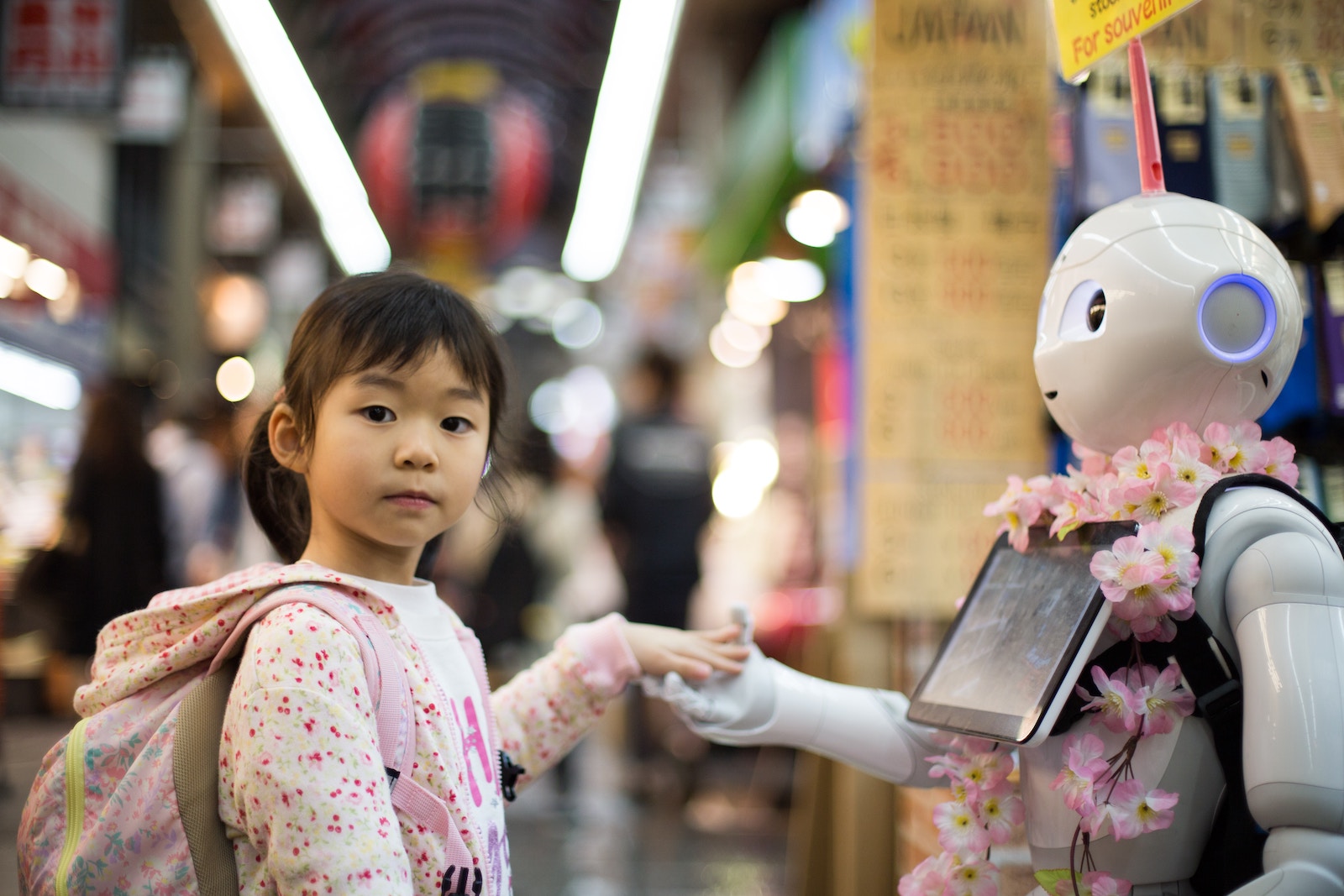
24 Apr How AI will impact our children’s lives in the future
In today’s rapidly evolving world, there’s a powerful force shaping our lives and our children’s futures: artificial intelligence (AI). From helpful virtual assistants to self-driving cars, AI is becoming increasingly prevalent in our daily lives. As parents or educators, it’s important to understand how AI will impact children and how we can prepare them for this exciting new era.
AI, in its simplest form, refers to machines or systems that demonstrate human-like intelligence by learning, reasoning, and making decisions based on data. Its potential for driving technological advancements and transforming industries has become very clear. It’s huge. However, when it comes to our children, it’s natural to have concerns about how AI will shape their experiences and opportunities growing up.
In this article, we will delve into the topic of how AI will impact our children’s lives in the future, and discuss both the positive and negative aspects that parents may consider. By understanding the potential benefits and challenges of AI, we can better guide our children and help them navigate the changing landscape with confidence and resilience.
Understanding AI
You may have heard of or played around with the ChatGPT chatbot, but this kind of software is only one area of AI technology. There’s also:
Machine learning: this type of AI enables machines to learn from data and improve their performance over time. It’s behind recommendation systems, personalised ads, and voice recognition.
Natural language processing: This AI branch focuses on understanding and processing human language. It powers voice assistants like Siri and chatbots that provide customer support.
Computer vision: AI’s ability to interpret and understand visual information is used in facial recognition, object detection, and self-driving cars.
Robotics: AI and robotics work hand in hand to create intelligent machines that can perform tasks autonomously, like assembly line robots or even advanced humanoid robots.
…and that’s just a few. There are several other branches of artificial intelligence!
AI is already present in our lives, with virtual assistants like Siri, Alexa, or Google Assistant providing voice-activated assistance for everyday tasks. AI is also used by our entertainment services to suggest movies, shows, or products through personalised recommendations. You’re also likely using AI-powered apps on your phone or computer that offer tailored experiences.
AI is transforming industries as we know them. In healthcare, AI assists in diagnosing diseases, analysing medical images, and developing personalised treatment plans. Transportation is being revolutionised by self-driving cars, promising safer roads and increased accessibility. In the entertainment industry, AI enhances gaming experiences by creating lifelike characters and enabling immersive virtual reality.
Our lives are going to look very different in a matter of years. Our jobs too. This means that today’s schoolchildren will face an entirely different reality to ours when they’re in their twenties and thirties.
The impact of AI on the next generation
8 benefits of AI for children
AI brings several positive impacts to children’s lives, offering exciting opportunities for learning, creativity, and personal growth. It also has the chance to drastically improve the quality of living for society in the future.
Enhanced learning experiences
AI-powered educational platforms adapt to children’s individual needs and learning styles. They provide tailored lessons, exercises, and feedback, which help children engage and grasp new concepts more readily. With personalised learning, children can learn at their own pace, ensuring a deeper understanding of subjects.
Creative opportunities
Digital art tools, for example, leverage AI technology to enable children to express their artistic talents, allowing their creativity to flourish. Similarly, music composition software powered by AI assists children in composing their own tunes, encouraging musical exploration and expression. This can really support their creative development because they can achieve pleasing results far quicker than with traditional art forms.
Enhanced accessibility
AI technologies have the potential to improve accessibility for children with disabilities by providing assistive tools and adaptive learning experiences tailored to their specific needs. AI-powered speech recognition and text-to-speech systems, for example, can enable children with speech impairments to communicate more effectively.
Improved medical or psychological diagnostics
Today’s children will benefit from a lifetime of improved medical interventions, one of the most significant areas AI will impact in the coming decades.
Augmented reality and virtual reality experiences
AI-powered augmented reality (AR) and virtual reality (VR) experiences can provide immersive and interactive learning, creations and entertainment environments. Children can explore historical landmarks, scientific concepts, or even virtual museums, enhancing their understanding and curiosity, without any long car journeys!
Language learning assistance
AI-powered language learning apps and tools can help children develop language skills by providing interactive exercises, pronunciation feedback, and language immersion experiences. These tools can make language learning more engaging and effective, promoting communication and cultural understanding. Translation tools can facilitate communication and cultural exchange among children from different linguistic backgrounds. Children will be able to interact, collaborate, and learn from peers around the world.
Virtual mentors and role models
AI-powered virtual mentors or role models can inspire and motivate children. Virtual characters or chatbots can provide guidance, encouragement, and positive reinforcement, helping children build confidence, set goals, and develop valuable life skills. Today’s entrepreneurs and coaches are already able to create AI versions of themselves and serve their clients and audience around the clock.
A more advanced world
It’s hard to be specific about what the future benefits for the next generation will be. What we do know, is that humans will be able to create and achieve far more with existing resources that they’ve ever been able to before. By magnitudes. This means that, in general, the quality of life for the kids of today should be dramatically higher in years to come.
5 risks and concerns of AI for children
While AI brings numerous benefits to our children’s lives, it is understandable for parents to have concerns about its potential drawbacks. After all, we’ve already seen pushback by industry leaders and lawmakers struggling to make sense of it all. By addressing these concerns and adopting a balanced approach, we can ensure that our children navigate the AI landscape safely and responsibly.
Privacy and data security
One common concern is the collection and use of personal data by AI systems. As parents and educators, it is essential to choose AI-powered tools and platforms that have strong data protection measures. Look for transparency in data handling practices, secure encryption methods, and clear privacy policies. Educate children about the importance of safeguarding personal information and teach them responsible digital habits.
Screen time and digital well-being
The increasing presence of AI in children’s lives may raise concerns about excessive screen time and its impact on their well-being. It is important to establish healthy boundaries with technology and balance online activities with other offline experiences. Encourage physical activities, social interactions, and creative pursuits to maintain a well-rounded lifestyle.
Digital literacy and critical thinking
AI technologies are constantly evolving, and it is crucial for children to develop digital literacy skills and critical thinking abilities. Teach children to question and evaluate the information they encounter online, including AI-generated content. Help them understand the limitations and biases that AI systems may have, empowering them to make informed decisions and navigate the digital landscape responsibly.
Balancing AI with human interaction
While AI can enhance learning and engagement, it is essential to maintain a balance between AI-powered experiences and human interaction. Encourage face-to-face interactions, family time, and social connections to foster emotional intelligence, empathy, and social skills that AI cannot yet replicate.
Future job landscape
With AI’s increasing role in various industries, parents may worry about its impact on future job prospects for their children. However, AI also presents new opportunities and careers. Emphasise the importance of developing skills that complement AI, such as creativity, critical thinking, problem-solving, and adaptability. Encourage lifelong learning and the pursuit of diverse interests, preparing children for a future where human skills will remain valuable.
By addressing these concerns and promoting a balanced approach, we can ensure that our children leverage the benefits of AI while navigating its potential challenges.
Concluding
By fostering digital literacy, critical thinking, responsible use, and ethical values, we equip them with the tools to thrive in an AI-driven world while maintaining their well-being and human connection.
Today’s children are already using AI. They’ll grow up knowing its capabilities and, with the help of parents and educators, they’ll quickly understand how to utilise it for their entertainment, career and business aspirations.




